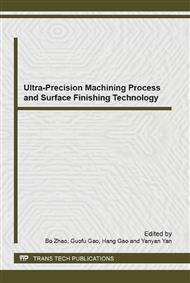[1]
G. C. Wang: Metal cutting burrs. (Jilin Press of science and technology, Jilin, 1997. 11).
Google Scholar
[2]
Y. M. Zhu: Study on Formation and controlling of Metal cutting Burr and Development of Burr Expert System. (Ph. D. Jiangsu University 2006).
Google Scholar
[3]
G. L. Chern. D. A. Donfeld: Burr/Breakout Model Development and Experiment Verification, Journal of Engineering Materials and Technology. vol. 118 (1996), P 201~206.
DOI: 10.1115/1.2804887
Google Scholar
[4]
I. W. Park. D. A. Donfeld: A Study of Burr Formation Process Using the Finite Element Method: Part (II), Journal of Engineering Materials and Technology. ( 2000), 122, P. 229~237.
Google Scholar
[5]
Q.X. Shen, G.C. Wang, Y.M. Zhu, et al:Transformation of Cutting Burr/Fracture in High Speed Machining Al-Alloy. Advanced Materials Research. Vols. 53-54 (2008):101-107.
DOI: 10.4028/www.scientific.net/amr.53-54.101
Google Scholar
[6]
K.Z. K Iwata, K.J. Ueda and K.C. Okuda: Study of Mechanism of burr Formation in cutting Based on Direct SEM Observation. (1982), P. 94~99.
Google Scholar
[7]
Zhao Zhude,Yao Liangjun,Peng Ruqing. Handbook of Copper and copper alloy [M]. Beijing: Press of science and technology, 1993(in Chinese).
Google Scholar
[8]
M. G. Cockroft: Determinnattion of workpice flow stress and friction at chip-tool contact for high-speed cutting. International Journal of Machine Tools & Manufacture, (2000), P. 133~152.
DOI: 10.1016/s0890-6955(99)00051-6
Google Scholar
[9]
N. N. Zorev: Inter-relationship between shear processes occurring along tool face and shear plane in metal cutting, Proceedings of International Research in Production Engineering, ASME, New York. (1963)P42~49.
Google Scholar
[10]
H. J. Qu, G.C. Wang, Y.M. Zhu, etal: Transformation of Cutting Direction Burr/Fracture in Orthogonal Cutting [J]. Advanced Materials Research, 2012, vol426:P. 73-76.
DOI: 10.4028/www.scientific.net/amr.426.73
Google Scholar
[11]
M. Haimura.,Y. Ichang.,D. Brnfeld. Analysis of Burr Formation Mechanism in Orthogonal Cutting. Journal of Manufacturing Science and Engineering. 1999, 121(3): P1~7.
Google Scholar


